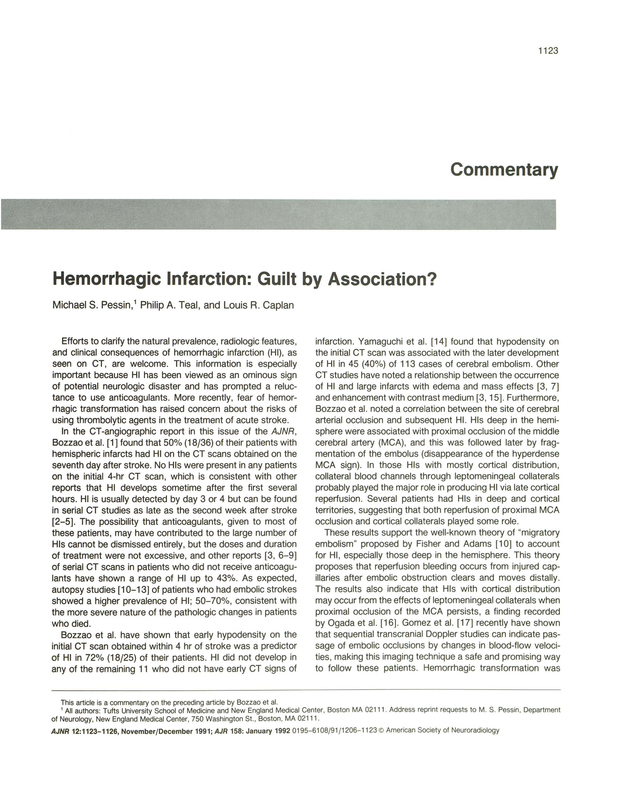Abstract
Hemorrhagic infarction: guilt by association?
M S Pessin, P A Teal and L R Caplan
American Journal of Neuroradiology November 1991, 12 (6) 1123-1126;
M S Pessin
Tufts University School of Medicine, Boston, MA.
P A Teal
Tufts University School of Medicine, Boston, MA.
L R Caplan
Tufts University School of Medicine, Boston, MA.


This is a PDF-only article. The first page of the PDF of this article appears above.
In this issue
Advertisement
Hemorrhagic infarction: guilt by association?
M S Pessin, P A Teal, L R Caplan
American Journal of Neuroradiology Nov 1991, 12 (6) 1123-1126;
Jump to section
Related Articles
- No related articles found.
Cited By...
- The Heidelberg Bleeding Classification: Classification of Bleeding Events After Ischemic Stroke and Reperfusion Therapy
- Alberta Stroke Program Early Computed Tomography Score to Select Patients for Endovascular Treatment: Interventional Management of Stroke (IMS)-III Trial
- Hemorrhage After Thrombolytic Therapy for Stroke: The Clinically Relevant Number Needed to Harm
- Asymptomatic Hemorrhage After Thrombolysis May Not Be Benign: Prognosis by Hemorrhage Type in the Canadian Alteplase for Stroke Effectiveness Study Registry
- The ALIAS Pilot Trial: A Dose-Escalation and Safety Study of Albumin Therapy for Acute Ischemic Stroke--I: Physiological Responses and Safety Results
- Extent of Early Ischemic Changes on Computed Tomography (CT) Before Thrombolysis: Prognostic Value of the Alberta Stroke Program Early CT Score in ECASS II
- In Acute Ischemic Stroke, Are Asymptomatic Intracranial Hemorrhages Clinically Innocuous?
- Baseline Blood Pressure but Not Early Computed Tomography Changes Predicts Major Hemorrhage After Streptokinase in Acute Ischemic Stroke
- Thrombolysis-Related Hemorrhagic Infarction: A Marker of Early Reperfusion, Reduced Infarct Size, and Improved Outcome in Patients With Proximal Middle Cerebral Artery Occlusion
- BRAIN IMAGING
- Neurological Deterioration in Acute Ischemic Stroke : Potential Predictors and Associated Factors in the European Cooperative Acute Stroke Study (ECASS) I
- Hemorrhagic Transformation Within 36 Hours of a Cerebral Infarct : Relationships With Early Clinical Deterioration and 3-Month Outcome in the European Cooperative Acute Stroke Study I (ECASS I) Cohort
- Ischaemic damage of brain microvessels: inherent risks for thrombolytic treatment in stroke
- Predictors of Hemorrhagic Transformation Occurring Spontaneously and on Anticoagulants in Patients With Acute Ischemic Stroke
This article has not yet been cited by articles in journals that are participating in Crossref Cited-by Linking.
Similar Articles
Advertisement





